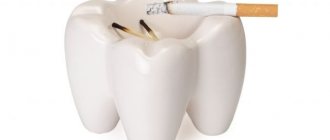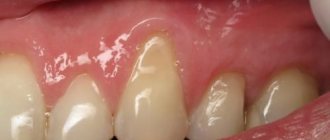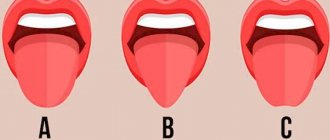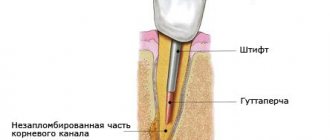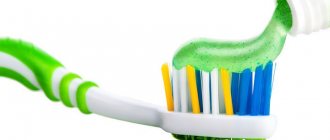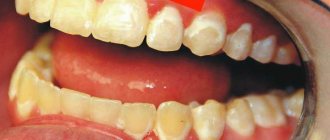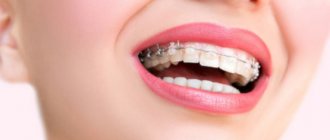The tongue helps a person perceive and distinguish a palette of tastes from salty to sweet, from sour to spicy. In the human mouth there can be from two to 10 thousand taste buds, which transmit information about taste to the brain via nerve endings.
If a person smokes, then over time the receptors lose sensitivity. What is this connected with? Why does smoking cause a coating on the tongue, find out from the article.
Coated tongue of smokers
According to statistics, 94% of smokers develop a coating on their tongue. Smoking is directly related to this problem, since the toxic substances contained in tobacco smoke disrupt the microflora of the oral cavity. Beneficial bacteria die and are replaced by fungi and bacteria that actively develop in a humid environment.
At the beginning, a white, dense coating appears, the consistency of thick sour cream. Over time, it darkens from the effects of nicotinic acid , which is part of the composition. To cure a person, the doctor takes swabs from the mouth and sends them for examination.
The type of bacteria or fungus is determined in the laboratory; after receiving the results, the doctor prescribes medications that act on this type of microorganism. It is quite difficult to get rid of this problem on your own, so for treatment it is necessary to identify the type of bacteria.
Video taken from channel: JitZdorovo
In addition to light deposits, a dark, brown or even black shade can also form. Its appearance may be a symptom of more serious diseases associated with the functioning of internal organs, in particular the digestive or cardiovascular systems.
It is necessary to review your own diet , and also make meals more frequent to improve your metabolism. Many smokers have a decreased appetite due to receptor contamination, resulting in fewer meals. To restore the functioning of the gastrointestinal tract, and therefore get rid of plaque, it is recommended to adhere to a healthy, proper diet, and try to minimize the intake of alcohol, sweet soda, coffee and coloring products.
In medical practice, problems with the appearance of sediment on the tongue are often associated with problems of the cardiovascular system caused by prolonged smoking. So if a person takes a drag from a cigarette, then a sharp spasm of blood vessels occurs in his body, and they begin to narrow. Severe narrowing leads to the collapse of the walls of the vessel, and it stops letting blood through.
If the vessel collapses at the tip of the tongue, the body will not be able to provide blood supply to this place and the cells will gradually begin to die. The process leads to the formation of an ulcer with clear boundaries. To avoid problems with the cardiovascular system, it is necessary to undergo an examination by a cardiologist as a preventative measure.
Modern medicine is able to cure this problem in the early stages without surgical intervention. The main thing is to consult a doctor in a timely manner.
What does plaque on teeth from smoking look like?
Plaque on teeth from smoking is usually yellow or brown. A few hours after brushing your teeth, the enamel is covered with a microbial film, which is easily removed with a brush and toothpaste. But in a smoker, the immune system in the oral cavity is significantly reduced and the process of reproduction of cariogenic microorganisms is more active. Therefore, a yellow-brown plaque forms faster than in a non-smoker.
You can look at what plaque on your teeth from cigarettes looks like. It differs in shade and density, depending on the duration of smoking.
Some people develop black deposits on their teeth, which indicate serious problems in oral health and may indicate the development of deep caries. Carious cavities and spots are invisible under the plaque. They can hide the initial signs of enamel damage.
In addition to plaque, other symptoms appear when smoking:
- bad breath;
- bleeding gums;
- exposure of the necks of the teeth;
- increased sensitivity of enamel;
- early tooth loss.
But infectious complications, which often arise when plaque on teeth from smoking is ignored, can be avoided. To do this, it is necessary to constantly maintain high quality oral care, carry out professional cleaning in the dentist's office and use home enamel lightening methods.
How to restore and clean teeth after smoking?
There are many ways to help get rid of the unpleasant yellow formation and restore enamel after smoking. Let's look at each of them in more detail.
Professional methods
Modern dental clinics offer professional plaque removal services. These include:
- Mechanical cleaning . This procedure is performed manually using ultrasound. This is the mechanical removal of plaque and tartar.
- Dry cleaning. Special chemical solutions are applied to the enamel to break down tartar and other formations. After treatment with these products, all excess from the surface of the tooth is easily removed.
- Combined cleaning. It includes both chemical and mechanical plaque removal. In this way you can achieve the desired result as quickly as possible.
Important! As for the popular procedure - teeth whitening, it is carried out only after dental cleaning (any of the listed methods).
After cleaning, the dentist must grind and polish the surface of the tooth enamel. This procedure will significantly reduce the rate of plaque re-formation.
Removing plaque at home
You can try to remove yellow formations yourself at home.
Alternative medicine offers many recipes to solve this problem.
The most effective in combating this unpleasant symptom are the following:
- Baking soda. This ingredient removes plaque well due to the fact that it contains abrasive particles. To prepare the solution you will need 1 tablespoon of baking soda and 1 teaspoon of water. Mix the ingredients, you should get a viscous paste. You need to put it on your toothbrush. Clean the oral cavity with this composition for 5 minutes, no more. It should be noted that plaque can be removed using this method no more than 1-2 times a week, otherwise tooth enamel will be damaged and cannot be restored.
- Hydrogen peroxide. This is one of the most effective, affordable and safe methods of removing plaque. You should soak a cotton pad or piece of cotton wool in the hydrogen peroxide solution so that it is damp, but not too wet. Apply to problem areas (for smokers these are usually the upper and lower front teeth) and hold for 5 minutes. At the end of the procedure, rinse your mouth with plain water. When using this method, you must be careful to avoid swallowing the peroxide. This can cause a burn to the mucous membranes.
- Lemon. This method is safe and there are no restrictions on its use. Its essence is that after smoking each cigarette you should chew 1 slice of lemon. This product prevents resins and other harmful substances from settling on the enamel.
- Activated carbon. Activated carbon should be ground to a powder. Apply it to your toothbrush and brush your teeth for 5 minutes. Despite the effectiveness of this method, it is necessary to control the intensity of cleaning. Because charcoal can damage tooth enamel.
- Tea tree oil. This component not only effectively removes plaque on teeth, but also has an antibacterial effect. The essence of the method is that after regular hygienic brushing of teeth, you need to drop a few drops of tea tree oil and brush your teeth again. Then you need to rinse your mouth with water. After the procedure, you may experience slight numbness, which will soon go away.
- Strawberries. This method is only relevant in the summer, when fresh strawberries grow. To remove plaque, you need to eat 1-2 berries after each cigarette you smoke. Strawberries contain fruit acids that destroy plaque.
It is useful for a smoker to introduce solid vegetables and fruits into the diet , such as apples, celery, carrots . They also effectively remove various formations on the enamel.
Cosmetology products
Know! To eliminate yellowness and whiten teeth, you can purchase cosmetic products and use them at home.
The most popular are:
- Whitening toothpastes. This is the simplest and most common type of bleaching agent. Such pastes contain abrasive particles. But you can use them to clean enamel only once a week, no more.
- Pencil. It impresses with its ease of use. In order to use the pencil, you need to squeeze out a small amount of gel using a dispenser and distribute it on problem areas with the applicator.
- Stripes. They are adhesive compounds that should be fixed to the teeth. The advantage of this method is that the strips do not cause discomfort. After gluing them, you can safely continue to do your business.
- Mouthguards. The whitening composition is poured into the tray and then fixed on the teeth. The advantage of this procedure is that the mouthguard enhances the effect of the gel, preventing it from draining.
A variety of methods for eliminating yellow formation and whitening enamel allows you to choose the most convenient one.
The harm of smoking on the human body
Nervous system
The nervous system controls all processes occurring in our body. It is responsible for the connection of the body with the external and internal environment. And first of all, it is the nervous system that suffers from tobacco poisoning. One of the first signs of tobacco poisoning of the nervous system is dizziness. Usually dizziness is accompanied by attacks, and sometimes by a series of attacks of great intensity. At first, a feeling of emptiness appears, the person cannot concentrate, and there is a feeling of loss of consciousness. It seems that all objects are moving, and if a person closes his eyes, a feeling of his own body spinning appears. Over time, smokers develop symptoms characteristic of a neurotic state: fatigue, irritability, memory loss, nervousness, headaches.
Respiratory system
The respiratory organs take the very first blow from tobacco poisons. Dense soot particles and the “bouquet” that is part of tobacco smoke products irritate the mucous membrane of the larynx, trachea, bronchi, the smallest bronchioles and pulmonary vesicles - alveoli. As a result of exposure, chronic inflammation of the respiratory tract develops. Smokers often suffer from bronchitis and are constantly tormented by a cough, especially worse in the morning.
The cough is accompanied by copious expectoration of dirty gray sputum. Constant irritation of the vocal cords, which is often found in smokers, makes his voice rough, hoarse, and unpleasant. Which in turn can become an obstacle to professional activity, for example (singer, teacher).
In one year, about 800 g of tobacco tar passes through a smoker's lungs. Therefore, the lungs of a smoker become darker than the lungs of a non-smoker. A constant painful cough entails a decrease in the elasticity of the lung tissue, causes stretching of the alveoli and the development of pulmonary emphysema. Scientists have proven that in people who smoke, lung function becomes less efficient in all respects. The resistance of the lungs to infectious diseases is significantly reduced.
Doctors have established a direct connection between smoking and tuberculosis. Tuberculosis occurs twice as often in people who smoke than in non-smokers. Smoking is one of the leading causes of lung cancer. Statistics are stubborn things, and they say that people who smoke are 10 times more likely to get lung cancer than non-smokers. Studies conducted in the USA and Europe have shown that the risk of lung cancer increases in direct proportion to the number of cigarettes smoked. The possibility of getting sick especially increases among those who are accustomed to using half-smoked cigarettes and take deeper puffs of smoke.
The cardiovascular system
The harm of tobacco smoking on the cardiovascular system is complex and varied. When smoking, your heart rate increases, and this happens after the first puff. In a completely healthy person, the heart beats 70 times per minute, and while smoking 80-90 times. In one contraction, the heart pumps 60-70 milliliters of blood, with 70 contractions per minute the heart pumps 4-6 liters of blood, in 1 hour this figure will be equal to 300 liters, and in 24 hours over 7000 liters. Now imagine that the heart beats not 70 times, but 85 times per minute, that is, 21% more often.
By simple calculations, it can be determined that in 24 hours the heart must pump not 7000, but 8470 liters of blood, which is almost 1500 liters more than under normal conditions.
This is the additional load our heart performs!
If a person is healthy, this load on the heart is not very great, but if a person has a diseased heart, then this load is difficult to bear. Experiments have shown that when smoking, the adrenal glands secrete hormonal substances that can cause an increase in blood pressure. This in turn further increases the load on the heart.
The heart expends more energy to drive blood through the significantly reduced lumen of blood vessels. As the diameter of the vessels decreases, the blood supply to the organs deteriorates and the temperature of the skin decreases. When smokers inhale carbon monoxide, the content of carboxyhemoglobin in the blood increases, which impairs the oxygen supply to the heart muscle.
Poor blood supply to the heart gradually leads to its fatty degeneration. Thus, smoking can cause the development of atherosclerosis, and atherosclerosis, in turn, can lead to an increase in the incidence of coronary heart disease, which is now often called the “disease of the century.” Coronary disease includes all heart diseases and disorders of its activity associated with a sharp decrease (general or localized) in the flow of blood into the vessels supplying the heart.
Smoking plays one of the first roles in the development of hypertension and atherosclerosis. WHO data indicate that mortality from coronary heart disease occurs more often in smokers and decreases in those who quit smoking. Sudden death attacks are four times more common in smokers than in non-smokers.
Harm of smoking to the digestive organs
Getting into the oral cavity, cigarette smoke irritates the tongue, gums, pharynx, it negatively affects tooth enamel and it begins to crack. Very often a smoker's breath smells unpleasant. Cigarette smoke irritates the salivary glands, resulting in excessive salivation. Scientists have found that smoking is a direct path to lip and tongue cancer.
According to a study by the World Health Organization, cancer of the oral cavity and esophagus is four times more common in smokers than in non-smokers. The toxic role of tobacco smoke is associated with mechanical, thermal and chemical effects. Toxic substances from tobacco smoke enter the digestive organs in different ways. Poisons enter the digestive system through the central nervous system, with saliva, and also through the circulatory system.
Statistics show a direct connection between smoking and stomach and duodenal ulcers. The mortality rate from these diseases is 3-4 times higher in smokers than in non-smokers. Tobacco smoke irritates the gastric mucosa and causes increased secretion of gastric juice with increased acidity. Constant irritation of the stomach can cause the development of chronic gastritis. Nicotine inhibits contraction (peristalsis) of the stomach and intestines. Doctors studying this phenomenon found that smoking a cigarette slows down stomach contractions, and sometimes stops altogether. Thus, smoking inhibits the motor action of intestinal functions.
This explains poor appetite and poor digestion in smokers. Smoking also causes invaluable harm to the liver. People who smoke often experience an enlarged liver, which goes away if the person stops smoking. Smoking also harms the pancreas. Smokers have twice the risk of cancer than non-smokers. If a non-smoking person is constantly in a smoky room, he is at risk of getting chronic gastrointestinal diseases.
Endocrine system
Numerous studies by scientists have shown that smoking has a detrimental effect on the endocrine glands. The sex glands are especially affected by tobacco. Toxic substances from cigarette smoke poison the gonads, which is associated with the occurrence of impotence in men. Observing women working in tobacco processing factories, the teachings revealed the harmful effects of harmful substances on their bodies. The women observed experienced menstrual irregularities, toxicosis during pregnancy became more frequent, and miscarriages were more common.
Sense organs
A smoker's tongue is constantly covered with viscous, thick mucus, which makes it difficult for food to contact the tongue and those nerve endings that perceive taste sensations. Many smokers, for example, do not like sweets...
This fact can be explained: tobacco inhibits the activity of nerve endings located in the oral cavity. This experiment has been carried out more than once: a smoker and a non-smoker were given slightly sweetened and lightly salted water to try. A non-smoker could easily distinguish the taste of water, while a smoker could not understand the difference. Often, due to a decrease in taste, a smoker’s appetite worsens.
The harm of smoking to the sense of smell. People who smoke stop perceiving shades of odors. Chronic smoking causes chronic inflammation of the mucous membrane of the nasal passages, which leads to chronic runny nose. The influence of tobacco poisons causes adverse changes in the optic nerve. The eyes of a smoker are always red, watery, and the edges of the eyelids swell. This leads to changes in visual perception, and can lead to complete blindness. Smokers often have impaired color vision.
Harm of smoking to hearing organs
Many smokers experience a decrease in hearing acuity. From constant exposure to toxic substances, chronic inflammation of the nasopharynx begins, spreading to the passages connecting the nasopharynx with the tympanic cavity. At the same time, the eardrum thickens and the mobility of the auditory ossicles decreases. All this taken together worsens hearing.
This is an incomplete picture of the harm smoking causes to our body. It is known that a dose of 0.1 g of nicotine is fatal to humans. It is contained in 20 cigarettes. Scientists have calculated that when smoking an average of 20 cigarettes a day, a smoker will smoke more than 200,000 cigarettes containing 160 kg of tobacco within 30 years.
This amount of tobacco contains approximately 800 g of nicotine - 8000 lethal doses of this poison. A person who injects one lethal dose of nicotine into his body every day does not die only because this dose does not arrive immediately, but gradually. The choice is yours to smoke and take a lethal dose of nicotine every day or to get rid of this addiction.
Passive smoking
Those around who inhale the smoke of a smoker are also susceptible to all the same diseases as the martyr himself, since most of the smoke with its harmful substances is not inhaled by the smoker, but is dissipated in the surrounding air, and non-smokers inhaling this air receive their dose of poison, which contributes to the development of various diseases in them.
If you care about your loved ones, quit smoking as soon as possible!
What diseases can plaque cause?
If in the early stages of smoking the appearance of plaque only visually worsens the condition of the dentition , then over time this habit can lead to more serious consequences.
develop :
- caries;
- chronic gum bleeding;
- gingivitis;
- periodontal disease;
- periodontitis.
According to statistics, smokers completely lose healthy teeth by the age of 65 .
Note! If we compare them with non-smoking people, then this indicator is 2 times higher.
Symptoms
The main symptoms of tongue swelling are its increase in size and swelling. In difficult cases, the patient has difficulty breathing, and there is a sensation of a foreign object in the mouth. The mucous membrane becomes loose, with prominent papillae, and tooth marks become noticeable on the lateral surfaces. Blood vessels become clearly visible on the lower part of the tongue.
Swelling is accompanied by other symptoms:
- Change in taste sensations.
- Change in color of the mucous membrane.
- The appearance of heaviness when swallowing.
- Increased body temperature.
- Swelling of lips.
- Hyperemia of the mucous membrane.
- Paleness of the skin.
If the problem is not detected in a timely manner, the tongue continues to swell, does not fit in the oral cavity, and falls out. The help of a doctor cannot be neglected. If the tongue is swollen and this process persists for several days, it is dangerous to self-medicate or wait until the problem goes away on its own.
Preventing dental plaque from nicotine
In any case, every smoker will sooner or later experience yellowing of his teeth. Therefore, every effort should be made to prevent this problem.
You should know! Prevention of dental plaque involves the following measures:
- Thorough brushing of teeth at least 2 times a day using a toothbrush, floss and mouthwash;
- timely replacement of toothbrushes ;
- rinsing your mouth after every cigarette you smoke;
- limit the consumption of strong coffee and tea;
- Regularly changing brands of toothpastes.
It is also necessary to regularly visit the dentist for preventive examinations, at least once every 6 months.
How to deal with it
So, you notice a coating on your tongue - what to do?
First of all, you need to analyze your diet - perhaps the change in tongue color is caused by eating certain foods and will soon go away on its own.
If the plaque is difficult to remove, and after a while it appears again, then it is most likely caused by internal disturbances in the functioning of the body. In this case, you have serious reasons to consult a doctor. The specialist will conduct a study, establish a diagnosis, prescribe treatment, recommend diet and preventive measures.
And finally, you should get rid of exposure to harmful factors - reduce your consumption of tea and coffee, regularly clean not only your teeth, but also your tongue. And, of course, quit smoking - otherwise all your efforts to get rid of plaque will be in vain, and the problem will arise again and again.
Why is tobacco considered harmful to the oral cavity?
For a long time, smoking was considered completely natural and safe, in fact, some experts even recommended tobacco to (supposedly) improve blood circulation and lung function. Everyone smoked: from ordinary peasants and workers to prominent politicians and movie stars of the first magnitude. The aestheticization of smoking was largely due to high-profile advertising campaigns and the activity of large corporations that could afford to spend millions to promote their products.
Experts spoke about the dangers of smoking in the 19th and early 20th centuries, but few listened to them. It was only in the second half of the twentieth century that the rise of diseases associated with excessive tobacco use and published research helped put the situation into perspective. Dentists were among those who drew attention to the dangers of smoking. Many studies have been conducted that have proven that smoking is one of the factors that provoke caries, periodontal inflammation and a number of other dental diseases.
Cigarettes contain hundreds of substances and components harmful to the oral cavity: nicotine, carcinogens, acetone, hydrocyanic acid, etc. “Smoker's teeth” have become one of the most common informal diagnoses in dentistry. This was also due to the fact that regular tobacco consumption was complemented by poor hygiene, poor diet and neglect of dental treatment. Someone will object and say that many smokers have completely healthy teeth and sometimes even a snow-white smile. This only means that a person makes great efforts to maintain dental health and has good genes, but in general this bad habit negatively affects the condition of the oral cavity and can still lead to problems and complications later.

